The tomato crop is one of the essential vegetables in terms of income and nutrition. Tomatoes are grown in fields, greenhouses, net houses, open air, and greenhouses in every country. After potatoes and onion, it is the world’s third-largest vegetable crop in production. As far as Indian crops are concerned, tomatoes are the most widely cultivated crop and are typically grown during the summertime, but they can also be grown all year round.
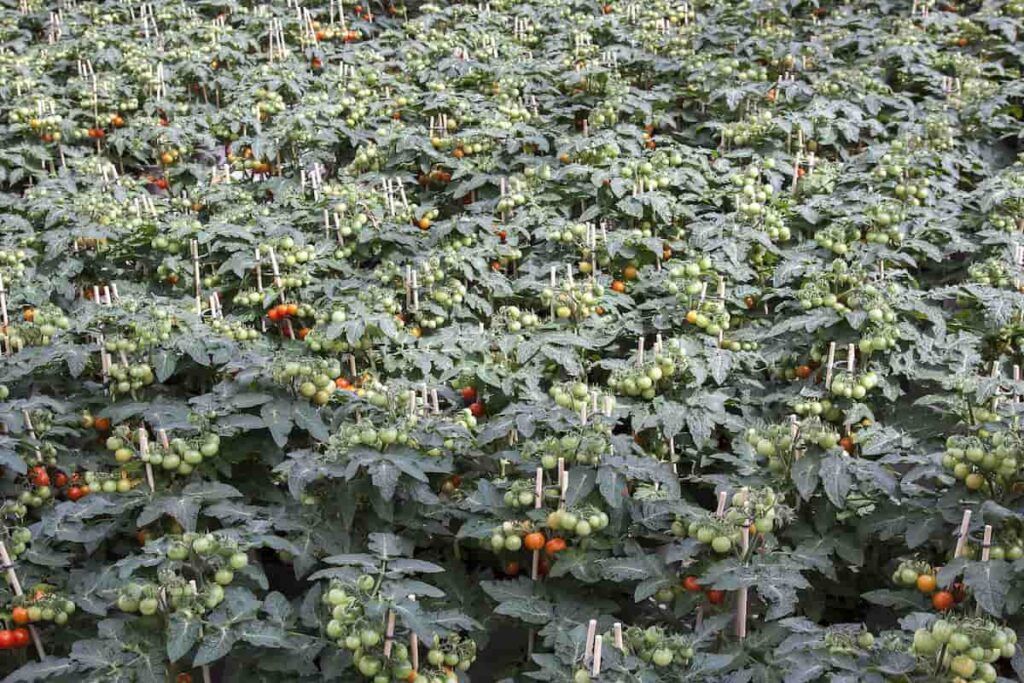
Regarding tomato production, the leading countries are China, India, the USA, Turkey, Egypt, Iran, Italy, Spain, and Brazil. With a production of 163.96 million tonnes worldwide, it occupies an area of approximately 4.73 million hectares. In general, tomatoes are a crop that grows best in warm climates. A temperature range of 20°C to 25°C is ideal for tomato cultivation.
Intense heat, such as temperatures over 43°C, burns the plants, and flowers and small fruits also fall, while temperatures less than 13°C and greater than 35°C decrease fruit production and red color. Vitamins such as Vitamin A and C, as well as antioxidants, are abundant in its fruit. In addition to the unique properties contained in the fruit, tomato demand remains almost the same all year long, due to the unique properties contained in its fruit. Tomatoes are used in various ways, such as pickles, chutneys, soups, ketchup, sauces, etc.
High Yield hybrid tomato varieties in India
The number of tomato varieties worldwide is over 15000, and they come in red and yellow varieties. The Indian tomato industry is estimated home to more than 1000 varieties. However, there are only a few commercially available varieties of these fruits, and others are consumed locally. Several seed companies have developed new varieties of tomatoes with specific traits to breed tomatoes further.
Summer season tomato varieties
It is relatively easy to grow tomatoes in the summer, as they are considered warm-season crops and are usually sown between March and June. Tomatoes should be grown between 21°C and 24°C to obtain the best results. However, summers can get hot in some regions of India. Although, it is also possible to cultivate tomatoes indoors and in greenhouses if they are meant to be grown for commercial use. The following are the few summer tomato varieties found in India during summer.
Pusa Hybrid
This variety was introduced by the Indian Agricultural Research Institute in New Delhi. Despite being hardy and tolerant of hot, humid climates, it can withstand temperatures as high as 30 to 35°C. Generally, the fruits produced are round and have thick but shiny skin. It is estimated that between 25 and 32 tons of fruit can be harvested per hectare.
Pusa Ruby
An average-yielding hybrid cultivar of tomatoes was also developed at IARI, Delhi, and is an example of a hybrid cultivar. It is an early-growing variety with an average yield of 28 to 30 tonnes per hectare and produces well early in the season. It is a popular choice for cultivation during the spring and summer, mainly because it can be cultivated outdoors. In terms of maturity, it is a cultivar that matures very quickly. It has an average height of 80 to 85 cm and an indeterminate life cycle. Fruits of this variety are flat or spherical in shape, medium in size, and have a slightly acidic pulp. The variety is suitable for processing and use as a table variety.
Arka Saurabh
A characteristic bump at the apex of this variety makes it easy to identify. Bangalore’s Indian Institute of Horticultural Research introduced this variety. This variety produces approximately 30 to 35 tonnes per hectare. The plants have a semi-determinate growth pattern, and the foliage is light green. It produces medium-sized (70 to 75 grams) fruits with a light green shoulder. The product is suitable for table purposes and processing.
In case you missed it: Tomato Farming Information Guide
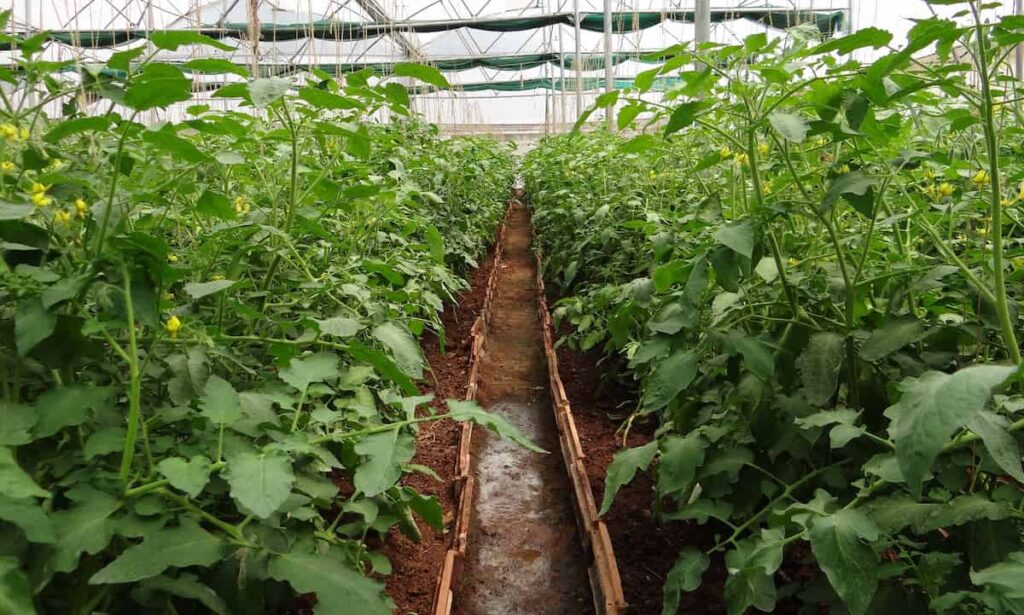
In 140 days, the crop matures after being cultivated in the Kharif or Rabi season. Among round-fruited varieties, it keeps well at room temperature for 8-10 days. This fruit has a very good balance of sugar and acidity and is suitable for fresh and processing purposes, such as making ketchup and juice.
Arka Abhijith
IIHR, Bangalore, released this high-yielding hybrid variety. The plants are semi-determinate with dark green foliage; the fruits are round, medium-sized (65 to 70 grams), and have a green shoulder. Fruits with thick flesh have a long shelf life, making them suitable for long-distance transportation. Suitable for table purposes. The plant is resistant to bacterial wilt. Crops are cultivated during Kharif/Rabi season and mature in 140 days. An average yield of 65 tons per hectare is achieved.
Arka Shreshtha
Developed by IIHR, Bangalore, this hybrid variety is high-yielding. Leaves are light green and semi-determinate. These plants produce medium-sized fruits (70 to 75 grams) rounded with soft green shoulders. Firm fruits with good keeping quality for almost 17 days and long transportability. Both fresh and processed markets are suitable for this product. The plant is resistant to bacterial wilt. It matures after 140 days of cultivation during Kharif or Rabi seasons. Per hectare, the average yield is 76 tons.
Arka Vikas
IIHR Bangalore developed this hybrid tomato variety in India. The fruit is oblate, medium-large (80 to 90 grams), with a light green edge, and turns deep crimson when ripe. It is adapted to rainfed and irrigated environments and developed for a new market. Tomatoes of this variety are best suited for table use. After planting, this variety takes 140 days to mature, yielding an average of 35 tons per hectare.
Arka Vishal
Arka Vishal is a hybrid tomato variety released by IIHR and an indeterminate plant. The fruit is huge and weighs about 140 grams. Tomatoes of this variety should only be used for table purposes. Kharif/Rabi season is the best time for cultivating this variety. It matures within 160 days. Per hectare, 75 tons are produced on average.
Pusa Early Dwarf
India’s IARI New Delhi developed this hybrid tomato variety. This cultivar quickly ripens because it is a determinate type. The tomatoes have a flattish round shape, medium size, and yellow stem ends. It takes 75 to 80 days after transplantation for the tomatoes to be ready for harvest. A hectare of land produces 35 tons of tomatoes on average. Tomatoes of this variety are suitable for both table use and processing.
Vaishali
Vaishali is a determinate hybrid tomato variety that produces medium-sized, high-quality fruits (100 grams). This cultivar thrives in hot, humid conditions. There is high resistance to Fusarium and Verticillium in this variety. Processing purposes, particularly in juice processing, are well suited to it.
In case you missed it: Growing Tomatoes Tips and Tricks
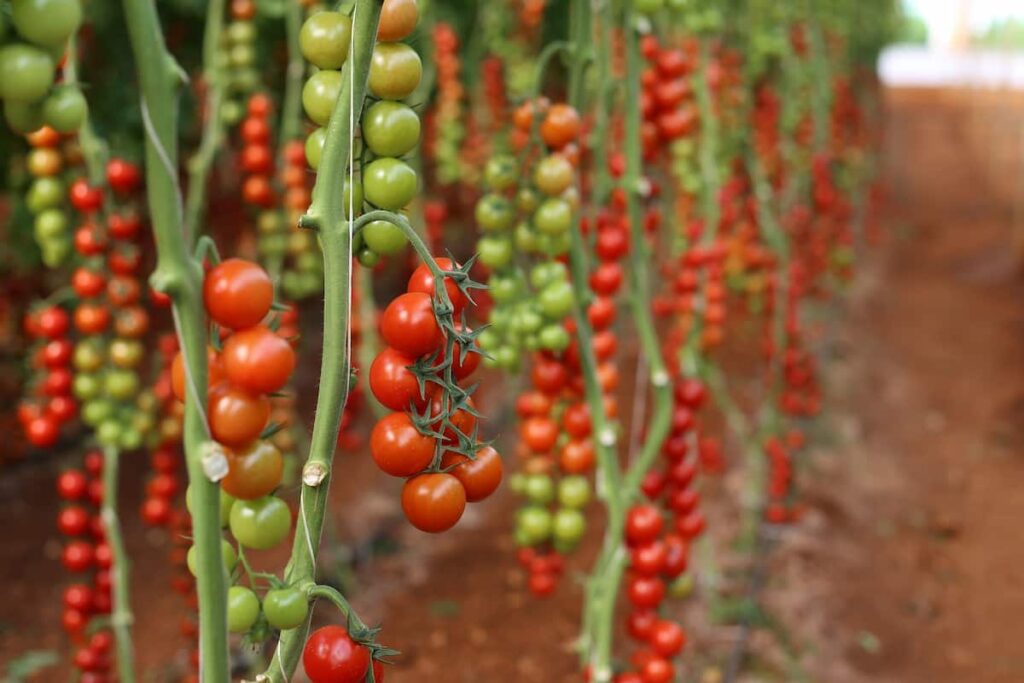
Co-1
The former Department of Agriculture, Tamil Nadu, recommended this new variety for the state. With dark-green foliage, the plant is dwarf with a semi-spreading habit. Fruits are round and smooth, with a pale green before ripening and a red color once ripe. Each fruit weighs about 125 grams and is borne in a cluster of six to eight. The average yield per hectare is 38 tons.
Arka Ashish
IIHR, Bangalore, developed it, an improvement over the California-based UC83 B. A plant’s maturity is determined by its concentration of fruit. As the fruit ripens, it is uniformly shaped, firm, bilocular, and oval. Ripe fruits store well on the vine for an extended period. Powdery mildew is not a problem for it. It makes excellent ketchup, juice, and puree thanks to its excellent color (Lycopene 10 mg/100g), low acidity (0.35%), and high TSS (4.8%). In 130 days, it yields 35 tons per hectare.
Winter season tomato varieties
Abhinav
It has broad leaves, excellent foliage, and a semi-determinate plant. Long-distance transportation is possible with it. It yields 60 to 65 days after planting and has a glossy, deep red color. In Kharif and Rabi, this tomato variety is cultivated. In addition to being firm and of good keeping quality, the fruits are suitable for processing. It weighs between 80 and 100 grams. Approximately 75 tons of tomatoes are produced per hectare on average
Namdhari
Namdhari, an Indian hybrid variety of tomatoes, is an early maturing variety with a determinate maturity date. It weighs between 80 and 90 grams and is attractive and glossy red. It is cultivated across nearly all states of India from August to October. The most common varieties can yield 40 to 60 tons per hectare, while Namdhari-4266 can yield 120 to 140 tons.
Rashmi
Round, firm, smooth, and brightly colored, the tomatoes have an excellent shape. Rashmi is a hybrid variety with a wide range of adaptability. The first harvest occurs about 70 days after planting, and the fruit weighs about 90 grams. Tomatoes of this variety are suitable for processing.
Pusa Gaurav
This plant is dwarf, bushy, and has moderate foliage coverage. Bushes bear fruits that are smooth and elliptical. The unripe fruits have a firm texture, thick flesh (0.6m), and two well-filled locules, making long-distance transportation easier. Its higher quality makes it suitable for canning and processing.
Rupali
The Rupali tomato hybrid produces medium-sized (100 grams), firm, round, smooth, and high-quality fruits that are determinate, compact, and early-growing. Suitable for processing, this variety is a good choice.
In case you missed it: How to Start Tomato Farming in Philippines: A Useful Growing Guide for Tomato Farmers
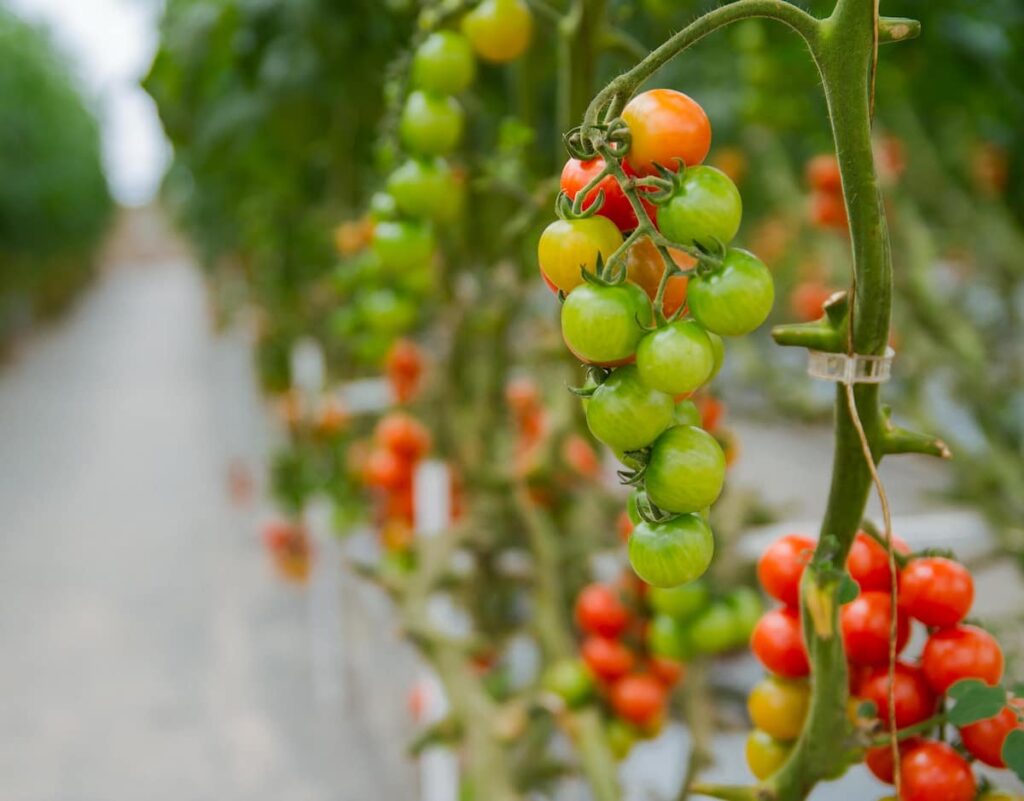
Arka Vardan
IHR, Bangalore, developed this hybrid tomato variety in India. Fruits weigh approximately 140 grams and have a green shoulder on this indeterminate plant. Table purposes are ideal for it. Crops are cultivated during Kharif or Rabi seasons and mature after 160 days. Approximately 75 tons of tomatoes are produced per hectare on average.
Arka Alok (BWR-5)
This variety is also bacterial wilt-resistant, developed at IIHR, Bangalore, from an accession obtained from the AVRDC, Taiwan. Within 125 days of transplanting, the crops have matured and are ready to be harvested. An average fruit weighs 100 grams and is square, round, and thick-fleshed with a light green shoulder. The yield potential is 35 tons per hectare.
Rainy season tomato varieties
EW-815
Tomatoes of this type show good resistance to bacterial withering and yellow leaf curl during the rainy season. These fruits are round and red with an average weight of 80 to 100 grams, resistant to blight, and suitable for distant markets. This variety yields approximately 90 to 100 tonnes of fruit per hectare. EW-815 can withstand adverse weather during rainy seasons, making it ideal for growing tomatoes in wet conditions.
Melkasalsa & Melkashola
Despite having a smaller fruit breadth, Melkasalsa and Melkshola tomatoes produce the highest marketable yield. These two species are most suitable for production under plastic shelters during the rainy season. According to records, Melkasalsa produces 22 tons of marketable fruit per hectare.
Arka Meghali
Through a cross between Arka Vikas and IHR 554, a new high-yielding tomato variety has been developed at IIHR, Bangalore. The average yield of 17.2 tonnes per hectare was compared to 10.9 tonnes per hectare for Pusa Ruby under rainfed conditions. It weighs between 63 grams and 65 grams per fruit.
Tomato season in India
A warm environment is essential for tomato growth, and they are usually planted in March and April and harvested in late summer in India. Plants begin to yield 70 days after transplantation. A variety of purposes are served by harvesting, including fresh market sales and processing. The tomatoes turn crimson red when they ripen, but the firm ones are used for fresh markets. Fully ripe fruit with soft flesh is used for seed extraction and processing. As a result of the increasing demand in the market, tomatoes are available almost throughout the year in India.
In case you missed it: Tomato Farming Guide for Beginners: Production Techniques, Process, and Steps
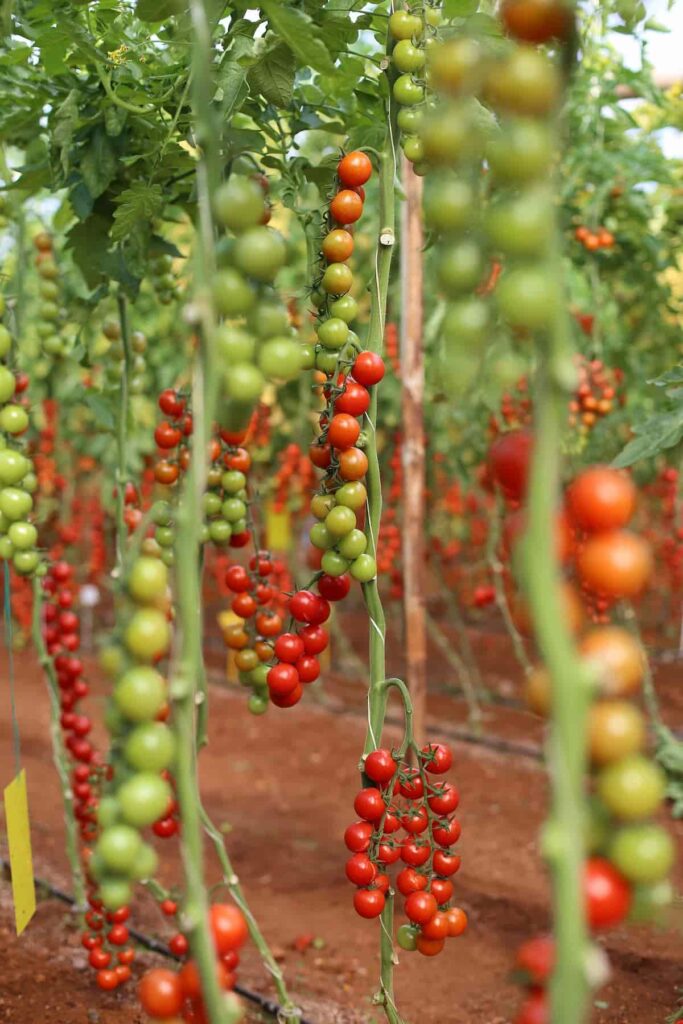
There is a substantial variation in yield per hectare depending on the type and season. On average, the yield per hectare ranges between 20 and 25 tons. Depending on the hybrid variety, tomatoes can produce 40 to 50 tons per hectare. Tomatoes reach their peak season in India between January and February and November and December. It is possible to grow tomatoes throughout the year in some states of India, such as Maharashtra and Gujarat. In the northern states, tomato season peaks in January and February, and the remaining months are lean.
It is grown from approximately mean sea level to an altitude of 1500 meters in tropical and subtropical climates with 60 to 150 cm of rainfall annually. Its development is adversely affected by excessive rain. It is grown as an irrigation crop when the weather is hot. Winter crop seeds are sown in August and September, and these winter tomato harvests are suitable for organic farming.
Growing seasons in various states
| Region | Transplanting | Harvesting Period |
| Southern and Western States | A – June – July | A – August – September |
| B – October – November | B – December – February | |
| C – January – February | C – March – June | |
| Northern and Eastern states | A – October – November | A – January – March |
| B – January – February | B – March – June | |
| Hilly states | A – May – June | A – July – September |
Harvesting
It usually takes 60-70 days for the fruits to become ready for harvest after transplanting. The harvesting stage will vary for what purpose the fruits are to be harvested. Harvesting consists of the following stages:
Dark green color
The fruit’s dark green color turns reddish pink during ripening. During this stage, the fruits that will be shipped are harvested. Before shipping, such fruits are sprayed with ethylene 48 hours in advance. Insufficient ripening and poor quality will result from immature green tomatoes. A sharp knife can be used to determine the maturity of a tomato. A fruit cut into seeds will not ripen properly and will be too immature for harvest.
Breaker stage
On 1/4 of the fruit, a dark pink color can be seen. This stage is the best time to harvest fruits so that they are of the highest quality. Tomatoes of this maturity tend to be more resistant to damage during shipment and fetch a higher price than those of less maturity.
In case you missed it: Vertical Tomato Farming: Modern Way of Getting More Yields in Less Space
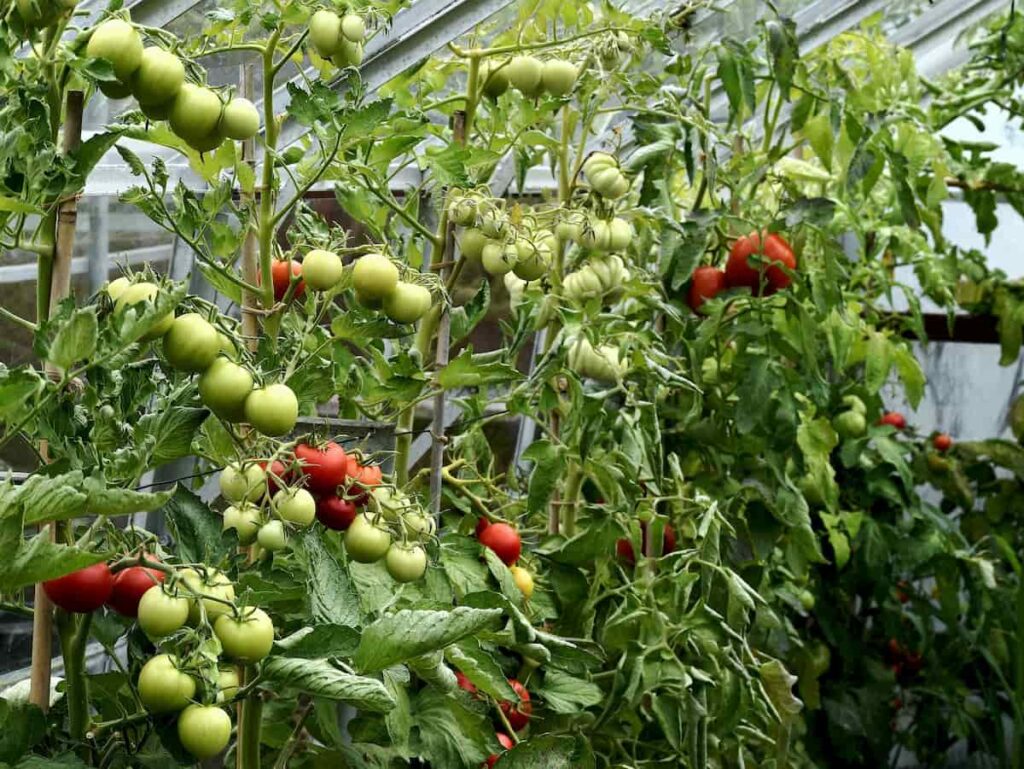
Pink stage
Three-fourths of the fruit was pink in color.
Reddish pink
Almost the entirety of the fruit turns a reddish-pink color. During this stage, fruits for local sale are harvested.
Fully ripped
The fruits are fully ripe and soft, having dark red color. Fruits like these are used for processing.
Typically, fruits are harvested in the morning or evening. Separating the fruits from the stem is done by twisting the hand. Keeping harvested fruits in baskets or crates under shade is the best way to store them. All fruits are harvested at an interval of four days because they do not mature simultaneously. It is common for a crop to have 7 to 11 harvests during its lifetime.
Conclusion
There is a significant variation in yield per hectare between varieties and seasons. Choosing the suitable tomato variety and sowing and harvesting times will make it easier for you to cultivate tomatoes.
- Irrigation and Water Management in Pineapple Farming
- Blossom to Harvest: Mastering Flowering and Pollination in Papaya Farming
- Pig Fattening Essentials: From Selection to Sale for Beginners
- Raising Wagyu Cattle: A Complete Guide for Premium Beef Production
- Soil Types and Their Water Holding Capacity
- Optimizing Irrigation Schedules for Coconut Groves for Enhanced Yield
- Espresso Your Garden: Coffee Grounds for Healthier Acid-Loving Plants
- The Best Soil Mix for Snake Plants: How to Mix Your Own Snake Plant Soil
- Green Thumb Success: Expert Tips for Cultivating Greenhouse Beans All Year Round
- Bloom All Year Round: The Ultimate Guide to Indoor Hyacinth Care
- Eco-Friendly Gardening: How to Make Liquid Fertilizer from Kitchen Waste
- Ultimate Guide to Grow Anise in Pots: Explore Seed Propagation to Harvesting
- Guide to Raising Chester White Pigs: Discover Breed Facts to Growth Management
- Mastering the Elegance: The Ultimate Guide to Weeping Cherry Tree Care, Planting, and Maintenance
- Ultimate Guide to Planting Garlic in Grow Bags: Growing Strategies for Beginners
- How to Fix Spider Plant Leaf-Related Problems: Natural and Organic Remedies
- 10 Reasons Why Your Tulsi Plant is Shedding Leaves: Home Remedies and Solutions
- Optimizing Growth and Yield: The Advantages of Palm Bunch Ash Fertilizer
- Utilizing Neem Oil Extract as a Natural Pesticide for Hydrangea
- From Soil to Harvest: Various Ways in Which Farmers Can Use AI Tools
- Steps to Encourage and Induce Citrus Flowers: A Comprehensive Guide
- How to Fix Snake Plant Leaf-Related Issues: Natural and Organic Remedies
- Transform Your Garden into a Fragrant Oasis with Raat Ki Rani (Night Blooming Jasmine)
- Discover the Ideal Chicken Breeds for Philippine Farms
- How to Create a Poultry Egg Farm Business Plan for Profits
- Grow Lemon Cucumbers Like a Pro: Insider Techniques for Bountiful Yields
- Ultimate Guide to Caring for Your Pink Princess Philodendron: Tips for Thriving Variegation
- Areca Nut Profit Per Acre: Calculating Yield and Cost of Cultivation
- How Kaveri Chicken is Becoming a More Profitable Breed in Indian Backyards
- Transform Your Barn: 9 Steps to Convert a Horse Stall into a Chicken Coop
- Exploring Suffolk Sheep Disadvantages with Limitations and Challenges
- Guide to Solving Potted Lemon Tree Problems: How to Revive Lemon Tree in Containers
- Steps to Encourage Female Pumpkin Flowers: Best Strategies for More Flowers and High Yields
- Ultimate Guide to Yellow Raspberries: Exploring from Planting to Care
- Ultimate Guide to Planting Ginger in Grow Bags: Growing Strategies for Beginners
- Ultimate Guide to Growing Red Creeping Thyme: Propagation, Planting, Pruning, and Care
